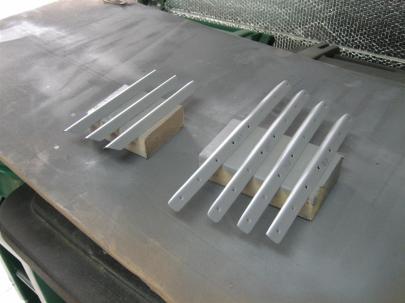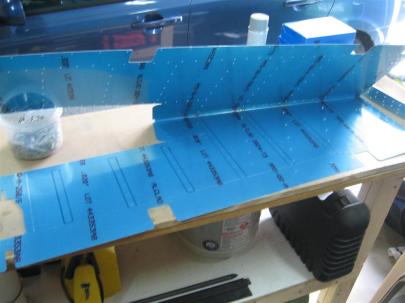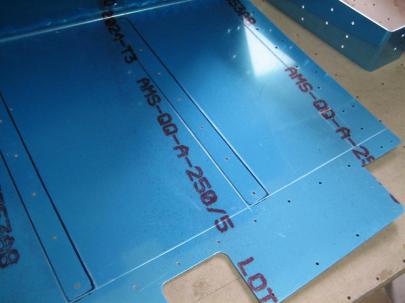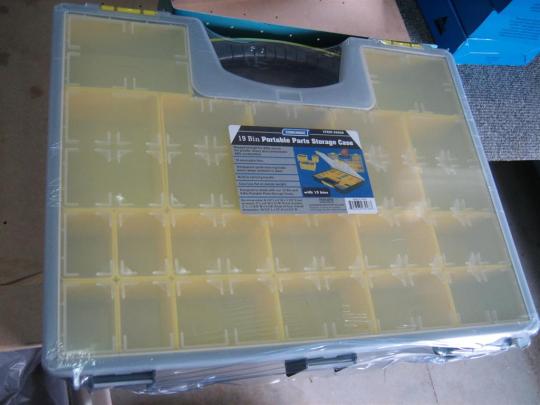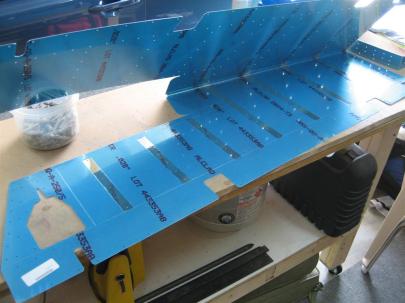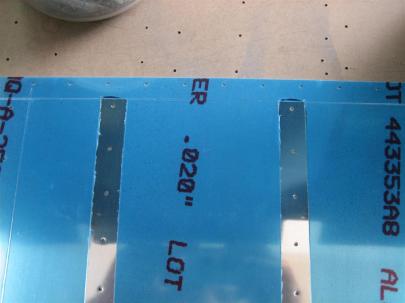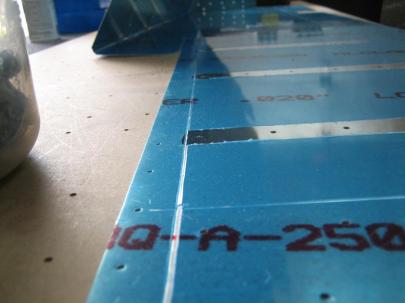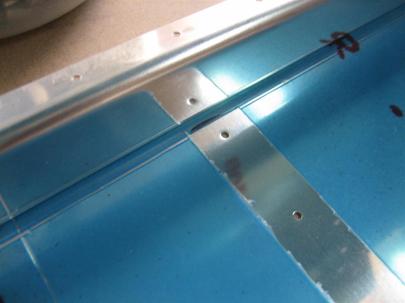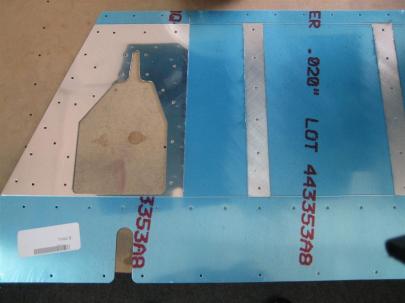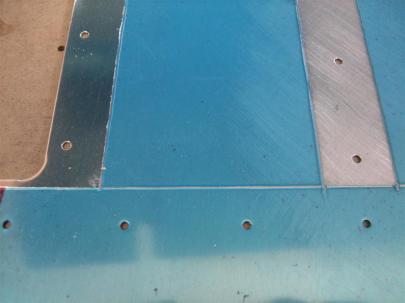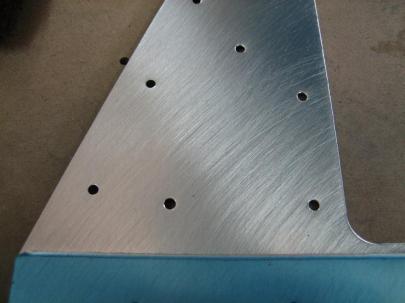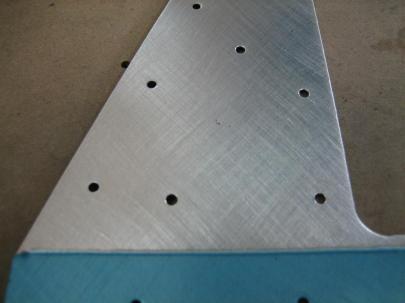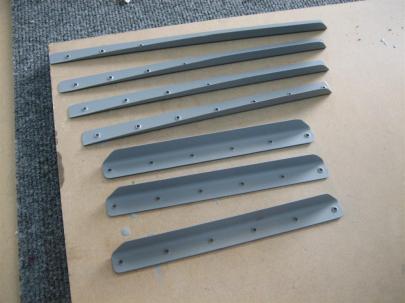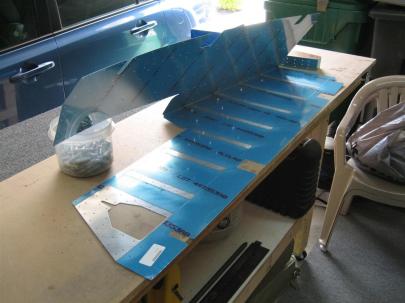Prev | Next
Well, tonight was the big night. I finally got started sealing up the right tank.
The general order is as follows:
- Backrivet stiffeners
- Rivet drain flange and fuel cap flange (don’t forget the vent clip!)
- Cleco all ribs into tank (to maintain assembly straightness)
- Starting with second-to outboardmost rib (the smallest area to work for bucking), seal and rivet each inboard rib. Assuming 7 ribs, from inboard to outboard, my order will be 6,3,5,2,4,7,1. That way, there’s always ribs on either side of the one I’m working on. This may be a waste of time, but it will make me feel better.
- Oh, before the inboardmost rib, I need to make sure I get the vent line in there, with the AN fitting, before bending and flaring the tubing to fit over the AN male fitting in the inboard rib.
- Install anti-hangup brackets, trap door, float sender (have to move this to 2nd bay) and flop tubes.
- Close tank.
- Have beer in celebration.
Oops, looks like number 8 will occur after each step (but only at the end of each night.)
Okay, let’s get to the pictures. I got out my new kitchen scale, the small and large popsicle sticks, rubber gloves (snap!), MEK, electrical tape, and paper towels out. Let’s see, what am I forgetting?
Oh YEAH, the Proseal. I guess it’s really called FlameMaster tank sealant, but I’m going to continue to call it proseal.
Also, I have 900 or so solo cups from my earlier partying days, and I thought those would be great for mixing proseal. (Caveat: when the directions tell you to swirl some rivets in MEK to remove the manufacturing oils, don’t use solo cups, the MEK burns through the white coating and the whole mixture becomes milky. Ask me how I know…at least I did a test before throwing in some rivets.)
First thing, I laid the stiffeners in place without rivets just to see where I needed to protect the rib lines with electrical tape.

Okay, let's start getting messy.
Anyway, I got some rivets soaked in MEK and then dumped them out on the paper towel.

asdf
I did a THOROUGH cleaning of both the skin and the stiffeners, then said a little prayer and got to proseal mixing.
I started with 2 oz. of white stuff and then added 0.2 oz of black stuff. (The picture reads 2.3 because I kept the popsicle stick.)

Oh, and I barely caught myself before using the white-stuff-soaked stick to scoop out some black stuff. That was close.
Anyway, I did my first batch in a solo cup, and I’ve decided to immediately switch to something wider and lower-lipped. In mixing the proseal, you basically push all the proseal up on the walls of the cup, and now you really only have an ounce or so to work with, because you’ve done a great job of sealing your cup. I feel like I wasted a whole bunch of proseal tonight having left most of it on the walls of the cup. Grrr.)

My first batch was the messiest because while stirring, all my gloved knuckles kept hitting the walls of the cup and gathering proseal.
Moving on, I grabbed a….CRAP…I don’t have anything to dab proseal into the dimples of the skin! Umm….Umm…
This cable tie will work! (It actually worked great, very similar to a toothpick that others use.)
Just to test out the process, I dabbed 4 holes of one of the outboard stiffeners, put some rivets in, spread sealant on the stiffener, laid it in place, and backriveted the heck out of it!

Looks okay, but why didn't you clean up the skin (you'll find out later).
Oh man, this stuff is MESSY. After reading a ton of build sites (Bullock’s, Oliver’s, Beaver’s), I was convinced I would make mine really neat compared to their’s.
By the end of the night, I felt like I was “arbitrarily slopped all over the place as a sort of voodoo talisman employed to ward off leak demons.” (Quote from Rick Galati.)
Anyway, I flipped the skin back over, put a dab of sealant in the rest of the dimples, taped over them all, flipped the skin back over, laid the stiffeners in place and got to backriveting.

Taped, ready to backrivet.

You can see how messy the outside of the skin is going to be.
It went well. The worst part is that by wet setting the rivets (sealant in dimple before inserting rivet), there is proseal all over the rivet on the other side. That means the proseal gets all over your rivet set, and therefore my hands as I steady the set during shooting (watch for my fingerprints later).
After getting all the rivets set, I grabbed more sealant and created fillets around each of the stiffeners.

Yikes, this is not very pretty.
Finally, I filled a little 20cc syringe I got from Target with sealant and encapsulated each rivet. This part worked REALLY well.

Tomorrow, the encapsulations look even better.

See my fingerprints?
As a final note, I followed Bill Repucci’s advice and resisted ALL TEMPTATION to wipe off the skin of the tank with MEK after backriveting. Apparently, some MEK might soak under the rivet head and work its way into a leak path. (No Leaks!). I’ll try the razor blade trick later, but just so you know, that’s why these skins don’t look as pretty as Bullock’s and Oliver’s.

Bill suggests using a razor blade to clean after a week or so.
In the end, it was about 2 hours and 78 rivets. not bad for a day’s work. It was wicked hot in the garage, and I was in desparate need of some refreshment once inside.

That'll do the trick.
Prev | Next





 Posted by Andrew
Posted by Andrew 











































































